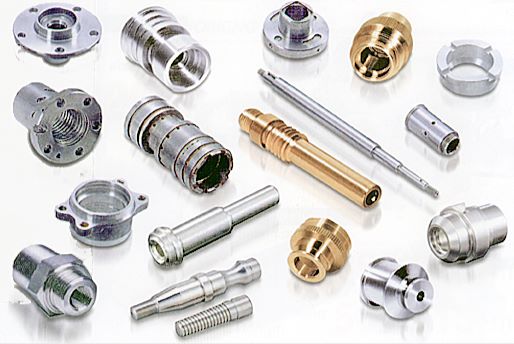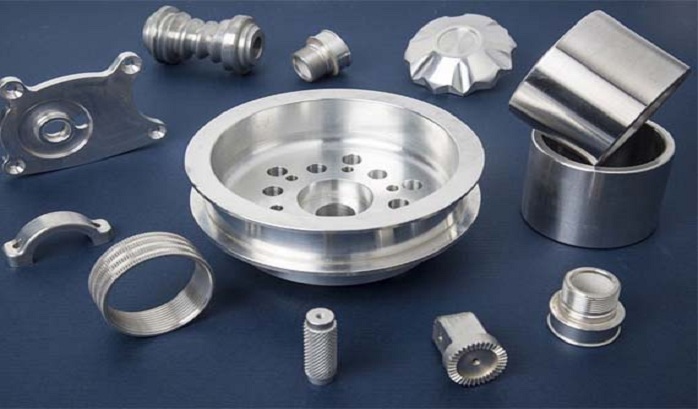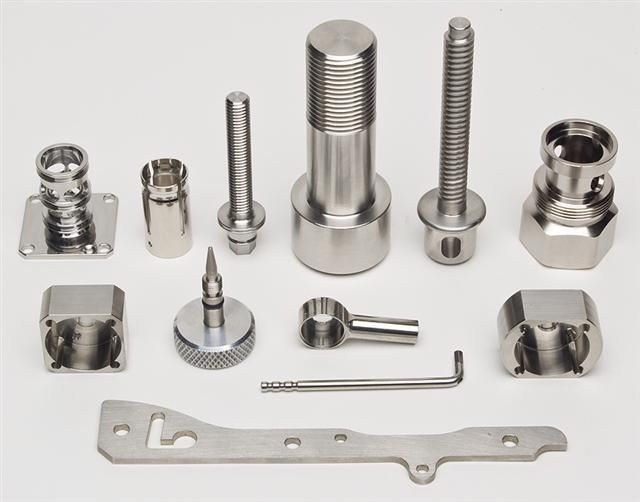CNC Machined Components
Machining
Machining is the process in which a material(often Metal) is cut to desired final shape and size by a controlled material removal process. We use powerful automation to make costume CNC machining easy. We’re eliminating slow and adequate processes with automated engineering tools to help you reduce development cycles and increase the speed at which project are delivered.

complex precision machined components
Our facility is equipped with the State-of-the-Art CNC machines, which allows us to create complex precision machined parts easily. The following equipment allows us to serve our clients better.
- 4-axis machining centers
- CNC lathes
- Live tool equipped CNC turning centers
- Horizontal and Vertical machining centers
- Tool Grinders
- Multi-tasking turning centers
complex precision machined components

Our facility is equipped with the State-of-the-Art CNC machines, which allows us to create complex precision machined parts easily. The following equipment allows us to serve our clients better.
- 4-axis machining centers
- CNC lathes
- Live tool equipped CNC turning centers
- Horizontal and Vertical machining centers
- Tool Grinders
- Multi-tasking turning centers
Specialty Engineered Products

At Swastik Technologies, we help develop technologically advanced machines that meet’s your specific needs by employing a highly specialized team that provides assistance with the assembly of the specialized tools and machinery.
No matter how small or big your asembly requirements are, we are equipped to precisely cater to it. From the initial conceptualization phase to complete assembly, we provide you with end-to-end asembly support.
Specialty Engineered Products
At Swastik Technologies, we help develop technologically advanced machines that meet’s your specific needs by employing a highly specialized team that provides assistance with the assembly of the specialized tools and machinery.
No matter how small or big your asembly requirements are, we are equipped to precisely cater to it. From the initial conceptualization phase to complete assembly, we provide you with end-to-end asembly support.


Health Care Division
In the healthcare industry, spare parts production plays a vital role in ensuring the smooth operation of medical equipment and devices. The availability of spare parts is crucial for timely repairs, maintenance, and replacements, ensuring that healthcare facilities can provide uninterrupted care to patients.
The production of spare parts for the healthcare division involves several key steps. It begins with the identification of the specific parts needed for medical equipment. This is typically done through collaboration between equipment manufacturers, healthcare facilities, and maintenance teams. A thorough understanding of the equipment’s specifications, components, and functionality is essential in determining the required spare parts.
Once the spare parts have been identified, the manufacturing process begins. Depending on the complexity and material requirements of the part, different fabrication techniques may be employed. Common methods include machining, injection molding, casting, and additive manufacturing (3D printing). The choice of technique depends on factors such as part complexity, material properties, cost-effectiveness, and production volume.
Health Care Division

In the healthcare industry, spare parts production plays a vital role in ensuring the smooth operation of medical equipment and devices. The availability of spare parts is crucial for timely repairs, maintenance, and replacements, ensuring that healthcare facilities can provide uninterrupted care to patients.
The production of spare parts for the healthcare division involves several key steps. It begins with the identification of the specific parts needed for medical equipment. This is typically done through collaboration between equipment manufacturers, healthcare facilities, and maintenance teams. A thorough understanding of the equipment’s specifications, components, and functionality is essential in determining the required spare parts.
Once the spare parts have been identified, the manufacturing process begins. Depending on the complexity and material requirements of the part, different fabrication techniques may be employed. Common methods include machining, injection molding, casting, and additive manufacturing (3D printing). The choice of technique depends on factors such as part complexity, material properties, cost-effectiveness, and production volume.
Aerospace Parts
The production of aerospace parts is a critical aspect of the aerospace industry, where precision, quality, and reliability are paramount. Aerospace parts encompass a wide range of components used in aircraft and spacecraft, including airframes, engines, landing gear, avionics systems, control surfaces, propulsion systems, and more. The manufacturing of aerospace parts requires adherence to stringent standards, advanced technologies, and rigorous quality control measures.
The process of manufacturing aerospace parts begins with design and engineering. Aerospace engineers collaborate with designers and manufacturers to develop detailed specifications and blueprints for each part. These designs consider factors such as structural integrity, aerodynamics, weight, material compatibility, and compliance with aerospace regulations.
Quality control is of utmost importance in aerospace parts production. Stringent inspections, non-destructive testing, and dimensional checks are conducted at various stages of manufacturing to ensure compliance with rigorous aerospace standards. Testing methods like X-ray inspection, ultrasonic testing, and spectroscopy are used to detect defects, flaws, and material inconsistencies.

Aerospace Parts

The production of aerospace parts is a critical aspect of the aerospace industry, where precision, quality, and reliability are paramount. Aerospace parts encompass a wide range of components used in aircraft and spacecraft, including airframes, engines, landing gear, avionics systems, control surfaces, propulsion systems, and more. The manufacturing of aerospace parts requires adherence to stringent standards, advanced technologies, and rigorous quality control measures.
The process of manufacturing aerospace parts begins with design and engineering. Aerospace engineers collaborate with designers and manufacturers to develop detailed specifications and blueprints for each part. These designs consider factors such as structural integrity, aerodynamics, weight, material compatibility, and compliance with aerospace regulations.
Quality control is of utmost importance in aerospace parts production. Stringent inspections, non-destructive testing, and dimensional checks are conducted at various stages of manufacturing to ensure compliance with rigorous aerospace standards. Testing methods like X-ray inspection, ultrasonic testing, and spectroscopy are used to detect defects, flaws, and material inconsistencies.

Other Engineering Industry
Precision Engineering parts production is a vital component of the engineering industry, responsible for manufacturing the various components and systems that make up a vehicle. These parts include engines, transmissions, chassis, body components, electrical systems, interior components, and more.
The production of engineering parts involves sophisticated manufacturing processes and technologies to ensure high quality, performance, and safety standards.
The process of manufacturing engineering parts begins with design and engineering. Automotive engineers and designers work together to create detailed specifications and blueprints for each component. These designs take into account factors such as functionality, durability, safety, and regulatory compliance.
Quality control is a critical aspect of engineering parts production. Rigorous inspections and testing procedures are implemented throughout the manufacturing process to ensure that the parts meet stringent quality standards. This includes dimensional checks, material testing, functional testing, and performance evaluations.
Other Engineering Industry

Automobile parts production is a vital component of the automotive industry, responsible for manufacturing the various components and systems that make up a vehicle. These parts include engines, transmissions, chassis, body components, electrical systems, interior components, and more.
The production of automobile parts involves sophisticated manufacturing processes and technologies to ensure high quality, performance, and safety standards.
The process of manufacturing automobile parts begins with design and engineering. Automotive engineers and designers work together to create detailed specifications and blueprints for each component. These designs take into account factors such as functionality, durability, safety, and regulatory compliance.
Quality control is a critical aspect of automobile parts production. Rigorous inspections and testing procedures are implemented throughout the manufacturing process to ensure that the parts meet stringent quality standards. This includes dimensional checks, material testing, functional testing, and performance evaluations.
